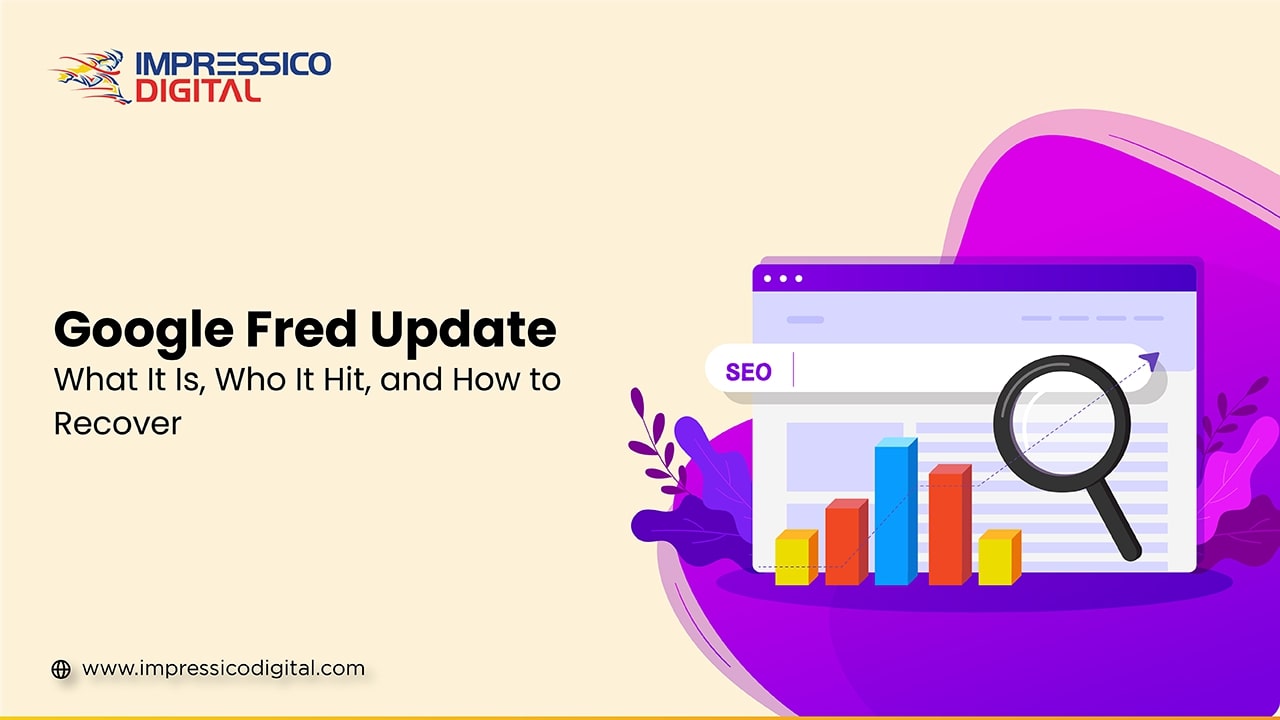The Google Fred update was introduced in March 2017 and caught the SEO community totally off guard. Overnight, numerous websites saw their traffic plummet—some losing up to 80–90% of organic visibility. What made it so impactful was the fact that it appeared to hit one particular set of sites: those focusing on revenue and ads over user value.
Fred wasn’t another adjustment. It was an extension of Google’s wider war against webspam and making sure people-first, useful, and trustworthy content ranked on the SERPs.
For a better understanding, consider Fred as a secret gatekeeper: if your website was great, it let you in; if you concentrated too much on monetization gimmicks, Fred shut the door.
Why It Matters Today
Although Fred was launched years ago, its philosophies haven’t disappeared. On the contrary, most professionals contend that Fred set the stage for the Helpful Content Update and contemporary Core Updates. Google’s algorithms are wiser nowadays, but they remain abiding by Fred’s fundamental philosophy:
- Users must come first, profits second.
- Visibility in search must be earned, not manipulated.
- Authority, expertise, and user experience reign supreme over shortcuts.
If your website relies on content-based traffic, knowing about Fred assists you in adapting to Google’s E-E-A-T standards (Expertise, Experience, Authoritativeness, and Trustworthiness).
History & Origins of the Fred Update
There was no official announcement of the Fred update with a focused Google blog post. SEOs reconstructed it from observation, forums, and interactions with Google reps.
- Timeline: Early March 2017 → site owners realize huge drops.
- SEO forums such as WebmasterWorld are filled with complaints.
- Barry Schwartz writes extensive reports on Search Engine Roundtable, noting common characteristics of impacted sites.
- Gary Illyes humorously refers to the update as “Fred” in a Twitter exchange.
The name is seemingly casual, but the impact was severe: entire companies vanished from Google’s top 10 overnight.
Who Was Hit — The Sites Impacted by Fred
Fred wasn’t a general “everyone hurts” update. It targeted a particular kind of site: those that prioritize ad revenue and aggressive SEO over true value.
Shared Characteristics of Affected Sites
- Affiliate-laden blogs: Sites filled with affiliate links but little depth.
- Ad-heavy sites: Banner ads, pop-ups, and video ads overwhelm the page.
- Thin content farms: 300–400-word articles, watered-down answers, and no true depth.
- Private Blog Networks (PBNs): Pages unnaturally linked to improve rankings.
- Clickbait aggregators: Pages scrape news and repackage it poorly.
Example: A recipe site with three paragraphs of fluff before presenting the actual recipe, surrounded by six ad units, frequently saw rankings fail.
Ranking Signals & SEO Factors Hit by Fred
Google has never provided a full “Fred checklist,” but from thousands of case studies and expert insights, these were the primary triggers:
Content Quality & Depth
Fred punished sites with superficial or copied content. A 300-word affiliate article reviewing “best shoes for 2025” without personal experience was likely to fall.
Best Practice: Create in-depth, expert-led content that addresses a subject comprehensively. Include pictures, videos, FAQs, and reputable citations.
Ad vs. Content Ratio
The content-ad ratio was one of Fred’s strongest indicators. If advertisements bogged down the user, then the page was not trusted.
Best Practice: Ads are okay, as long as they are balanced. For instance, 70% content, 30% monetization is better than the opposite.
Link Quality & Clean Profiles
Pages that used spammy backlinks, low-quality directories, or PBNs took a severe hit. Google’s algorithms became better at recognizing unnatural link patterns.
Best Practice: Prioritize editorial links from authoritative, related sites. No shortcuts.
Performance & UX Factors
Mobile friendliness, page speed, and intrusive interstitials were considered in Fred.
Best Practice: Conduct audits using Google’s PageSpeed Insights and Core Web Vitals to maintain a seamless user experience.
Real-World Impacts
Site A: Affiliate Tech Blog example
- Previously: More than 500 product roundups, all monetized via affiliate links.
- Post Fred: Traffic fell by 70%.
- Recovery: Eliminated duplicate reviews, re-posted with hands-on testing, included videos, and comparison charts. Restored ~50% traffic within six months.
Example Site B: Recipe Aggregator
- Before: Copied recipes from other blogs, loaded with obtrusive ads.
- After Fred: Lost 80% organic visits.
- Recovery: Eliminated ads above the fold, began publishing original family recipes with step-by-step photos. Traffic recovered modestly (~40%).
Example Site C: News Portal
- Before: Relied on rewritten news snippets and keyword stuffing.
- After Fred: Decline in both ranking and ad revenue.
- Recovery: Hired subject matter journalists, reduced ads, and added structured data. Rankings stabilized after a year.
These stories underline that recovery required fundamental changes, not just small tweaks.
How To Audit If You’ve Been Hit
Auditing for Fred’s impact is about identifying whether low-value practices exist on your site.
Checklist for Fred Audit
- Traffic Drop Analysis: Compare organic traffic before and after March 2017 (or after any significant update).
- Page-Level Review: Which pages lost the most traffic? Are they thin or ad-heavy?
- Ad Placement Review: Is content secondary to ads?
- Backlink Profile: Look for spammy or irrelevant backlinks.
- Content Relevance: Does your content offer original value, or is it something that can be easily replaced?
Tools such as Ahrefs, SEMrush, Screaming Frog, and Google Search Console become an essential part of this process.
Impressico Digital provides SEO audits that reveal such loopholes and enable businesses to fall in line with Google’s expectations.
Recovery & Mitigation Strategies
Restoration from Fred requires endurance, but it is achievable.
Content Overhaul
- Consolidate duplicate posts into in-depth guides.
- Insert original research, case studies, and pictures.
- Showcase firsthand knowledge.
Reduce / Optimize Ads
- Eliminate ads above the fold.
- Test various ad layouts for balance.
- Prioritize user-first monetization approaches.
Link Cleanup
- Employ Google’s Disavow Tool for spam backlinks.
- Move away from link schemes.
Content Refresh & New Content
- Refresh previous posts on a regular basis.
- Grow with multimedia (videos, infographics).
- Incorporate FAQs and user-generated content where appropriate.
Moz founder Rand Fishkin has long spoken to the point that “great content earns links, bad content earns penalties.” Fred merely ratified him.
Monitoring & Preventive Best Practices
Fred was a wake-up call, but volatility in algorithms persists. Prevention is currently the best defense.
- Regular Audits
Quarterly inspections ensure your site stays up to speed with Google’s changing standards.
- Culture of Quality-First Content
Content adheres to E-E-A-T principles: show expertise, include firsthand experience, and reference authoritative sources.
- Algorithm Monitoring Tools
- Google Search Console notifications
- SEMrush sensors
- Industry news sites such as Search Engine Land
At Impressico, our services may diversify traffic sources so that your business is not overly reliant on Google’s algorithm changes.
FAQs
Q1. What is the Google Fred update?
The Google Fred update was a 2017 algorithm change targeting sites with thin content, ad-heavy pages, and poor user experience.
Q2. Is Fred still relevant today?
Yes. While Google doesn’t officially use “Fred” anymore, its core principles are integrated into current ranking systems like Helpful Content and Core Updates.
Q3. How do I know if Fred hit my site?
Check analytics for sudden traffic drops in March 2017, or analyze thin content and ad-heavy pages that may still be at risk today.
Q4. Can a site recover from Fred?
Yes—through content improvement, ad optimization, and backlink cleanup, most sites regain visibility over time.
Q5. How long does recovery take after Fred?
Recovery may take weeks to months, depending on how quickly you fix issues and when Google re-crawls your site.
Q6. Does Google still utilize Fred?
Not by name. But its principles continue on in core updates and spam algorithms.
Q7. Why was my affiliate website targeted by Fred?
If your affiliate content was not original, full of excessive links, or contributed minimally to real-world experience, then Fred probably screened it out.
Q8. Is removing ads helpful for recovery?
Yes. Eliminating ad clutter enhances both user trust and page load time, which can improve rankings in the long run.
Q9. How is Fred different from Panda or Penguin?
- Panda aimed at thin content.
- Penguin aimed at spammy links.
- Fred aimed at the intersection of both + ad abuse.
Conclusion
The Google Fred update was one of the most significant algorithm changes of the past ten years. It revealed sites that cared more about making money than people and forever changed the SEO landscape.
Today, whether you’re an affiliate marketer, publisher, or business website owner, Fred’s lessons remain crystal clear:
Top 5 Expanded Action Items
- Audit ads vs. content balance on every page.
- Invest in expert-driven content that shows credibility.
- Prioritize user experience: speed, mobile-friendliness, clean design.
- Diversify traffic channels beyond organic search.
- Stay ahead of updates with regular audits and SEO news monitoring.
Want to ensure your site makes it through the next big algorithm update? Reach out to us for customized SEO services that protect your visibility and growth.
Want to know more about us? Follow us on social media!



